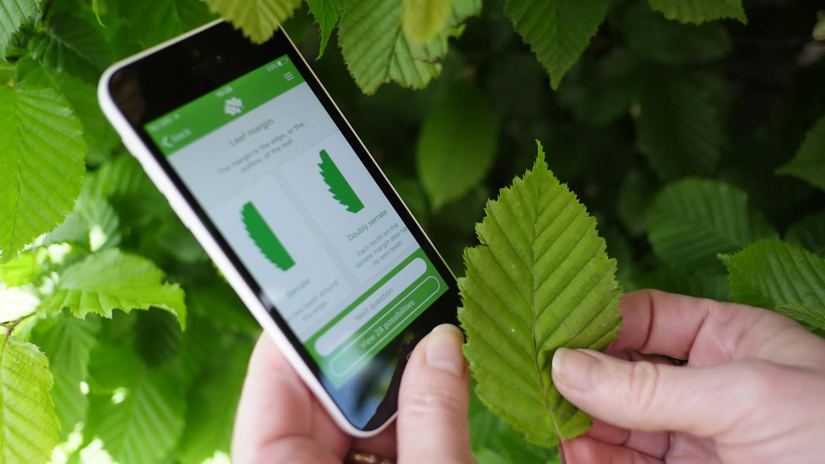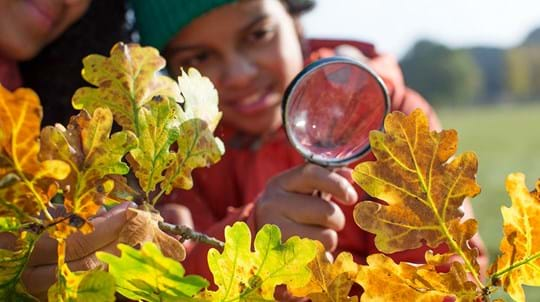
Credit: Colin Varndell / naturepl.com
Leaves
Toothed, and 7–16cm in length, they are larger than those of other elms. They have a characteristic asymmetrical base and taper to a sudden point at the top.
Decimated by Dutch elm disease, the sweeping and majestic wych elm is a much rarer sight these days. Its loss goes hand-in-hand with the decline of the elusive white-letter hairstreak butterfly, whose caterpillars rely on elm leaves.
Common names: wych elm, Scots elm
Scientific name: Ulmus glabra
Family: Ulmaceae
Origin: native
Trees can grow to a height of 30m. The bark is smooth and grey when young, becoming grey-brown and fissured after 20 years. Twigs are dark grey and covered in coarse hairs, and leaf buds are hairy, purple-black and squat in shape.
Look out for: the asymmetric leaf bases which are a feature of all elms. Leaves are rough to the touch on the top surface.
Identified in winter by: both bud and twig which are densely covered in orange hairs.

Credit: Colin Varndell / naturepl.com
Toothed, and 7–16cm in length, they are larger than those of other elms. They have a characteristic asymmetrical base and taper to a sudden point at the top.

Credit: Brian Legg / WTML
Appear before the leaves in early spring. They are red-purple in colour and grow in clusters of 10–20, spaced out along the twigs and small branches. Elms are hermaphrodite, meaning that both male and female reproductive parts are contained within each flower.

Credit: Colin Varndell / naturepl.com
After being pollinated by wind, flowers develop into small, winged fruits known as samaras. The seed is located at the centre of the wing and are dispersed by wind.

Download our free Tree ID app for Android and iPhone to identify the UK's native and non-native trees. It's an A-Z tree guide in your pocket.
Download the appDespite the English elm's name, wych elm is the only elm that is regarded as being truly native to the UK. As a result of Dutch elm disease, wych elm is now rare.
It usually grows in hilly or rocky woodlands, or beside streams and ditches. It is hardier than the English elm, so is found much further north and west, and in parts of Scotland.

Credit: Sandra Standbridge / Alamy Stock Photo
Many birds eat elm seeds and the leaves provide food for the caterpillars of many moths, including the peppered, light emerald and white-spotted pinion. Caterpillars of the white-letter hairstreak butterfly feed on elms and the species has declined dramatically since Dutch elm disease arrived in the UK.
Elm and ash were revered by the ancient inhabitants of Northern Europe as a sacred tree.
Elms used to be linked with melancholy and death, perhaps because the trees can drop dead branches without warning. Elm wood was also used for coffins.
In folk tales, elm holds the power to give you prophetic dreams.

Credit: Alex Hyde / naturepl.com
Elm wood is strong and durable with a tight, twisted grain, and is resistant to water. Wych elm is easier to work for carpentry than common elm as it will split. It has been used in decorative turning, and to make boat parts, furniture, wheel hubs, wooden water pipes, and floorboards.
Wych elm is highly susceptible to Dutch elm disease, a fungal disease which has devastated populations of elms since it arrived in the UK in the 1960s.
Elms can also be affected by galls from aphids.
Before metal was widely available, many English towns had elm water mains, including Bristol, Reading, Exeter, Southampton, Hull and Liverpool.

Shop
We have single trees and tree packs to meet your needs, from wildlife to woodfuel. Delivery is free.
External link

Take part in our Nature's Calendar survey
Tell us what's happening to the trees around you and help scientists track the effects of climate change on wildlife.
External link